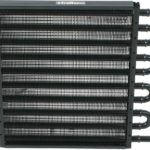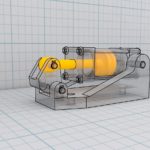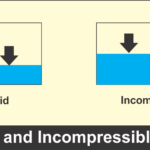你曾经想象过吗gear ratio没有齿轮可以可能吗?有趣的是正确的, what if the system creates countless gear ratios? To create an infinite gear ratio is an extraordinary thinking but is it possible? Yes, everything is possible when it is a matter of automobiles. The manual gearbox or traditional transmission system has a fixed number of gears and gear ratios. Metamorphosis of automotive technology is unpredictable and developed two pulley system of power transmission from the engine to the wheel. The vehicle withcontinuously variable transmission (CVT) more popular in recent years and Japanese automobile companies are good at using this technology in their vehicles. CVT is a simple and amazing mechanism that offers infinite gear ratios.
Table of Contents
Small History:

The Formula One (F1) sport is the most prestigious form of racing in the world. In 1993 The Williams FW15C for testing purpose they fitted with the completely different mechanism for transmission of power from an engine to the wheels. This test model of Continuously Variable Transmission (CVT) technology was banned by F1 before hitting on the race track. Because this technology used as driver aid which reduces the driver efforts from shifting gear without any action by driver and racing is not much challenging for completion. Another big reason behind the ban was CVT powered car is quicker thanmanual gearboxand at the same time, it produces more noise. Japanese automobile manufacturing companies adopted this technology and implemented CVT in a very effective way and successfully presented joyful and effortless driving experience to customers.
Also Read:
- Torque Converter Working, Principle, Main Parts and Application.
- Fluid Coupling – Main Parts, Principle , Working and Application
- How Automatic Transmission Works? – Best Explanation Ever
Main Parts
The basic CVT consist of (1) Primary pulley (2) Secondary pulley and (3) Belt
1. Pulley and Sheave:
Gearbox is an only way of connecting the engine to wheel. The vehicle does not require always same power or constant power output, sometimes high torque-low speed and low torque-high speed gear ratio done their work. In CVT system conical pulleys replaces gears arrangement that’s why it is also referred as pulley transmission. Drive pulley or primary pulley is directly connected to the crankshaft of the engine. Whereas driven pulley or secondary pulley is connected to drive shaft (Means Output shaft –Differential-Wheel).Both pulleys have static and moveable sheave, the combination of both static and moveable sheave called pulley. Both pulleys have its own axle shaft and parallel to each other. Infinite gear ratios can be achieved by both pulleys driven by belt while pulleys diameter varies according to the movement of sheaves. The direction of contraction and expansion of pulleys at both ends are different. If drive pulley expand then driven pulley contract at the same time and vice versa; let’s see how it works
At low speed:

At an initial stage, the vehicle required more torque (Doesn’t required speed) to move further, that’s why bigger gear used as a first gear in the manual transmission. In Continuously Variable Transmission system, belt pushes the pulleys and as soon as the crankshaft rotates the primary or driving pulley’s movable sheave moves away from the static sheave which makes the smaller diameter of the driving pulley. Due to the same movement of sheaves at the same time secondary or driven pulley becomes larger in diameter which leads to creating greater torque at the vehicle’s starting position.
At high speed or High Gear:
While accelerating, vehicle required high speed (Doesn’t required torque) for that driven pulley or secondary pulley diameter become smaller (smaller diameter more revolutions) as the moveable sheave moves away from the static sheave. Due to the same movement of sheaves at the same time, primary or driving pulley becomes bigger in diameter which creates gear ratio between them. One revolution at driving pulley is equal to four revolutions at the driven pulley.
How the sheave movement takes place?
Inside the conical sheave, it has cylindrical rollers. These rollers are subjected to undergo centrifugal force. Sheave pocket placed upon the rollers which take the movement of inside and outside as per roller gets centrifugal force. Whenever rpm increases or decreases these rollers push the pocket inside or outside.
2.推动带:
Push belt transfers the torque from driving pulley to the driven pulley. Two types of belts are used in continuously variable transmission. The V-Shape Kevlar rubber belt is used in the scooter which has more flexibility than the normal rubber belts. V-shape rubber can easily travel and pushes in-between the two pulleys. Steel belts are widely used in CVT; the construction of this belt is very unique, stronger and flexible than the V-shape belt. The complex steel belt has thin individual steel rings (Circular steel ring) and the whole bunch of small toothed steel elements that can easily travel and pushes the pulleys at any rpm range.
工作的缺点tinuously Variable Transmission (CVT)
The manual and automatic transmission systems have complex working which depends upon gear shifting. There, two gears can achieve gear ratio, but in CVT two pulleys mechanism provides not only a single gear ratio but countless or infinite gear ratio. Both are connected by a push belt, one pulley (Primary) is connected with the engine and another (Secondary) pulley with a drive shaft. Each pulley attached with a moveable sheave which causes expansion and contraction of the pulleys at both ends. As the engine turns the primary pulley and secondary pulley diameter size gets changed due to moving sheaves of both pulleys. If one pulley’s size is decreased, at the same time the second pulley’s size is increased and vice versa. The size variation of pulleys means diameters also varies which creates the continuous gear ratios. In manualgearboxinput and output gear teeth decides the ratios, but here variation in diameter decides the ratios.
For Better Explanation About Continuously Variable Transmission (CVT) Watch the Video Given Below:
- How Anti-lock Braking System (ABS) Works?
- Manual Vs Automatic Transmission
- Different Types of Engine
Advantages:
- Lightweight, compact, and easy to handle.
- Smooth-shifting and it offers a smooth ride, No up and downshifting problem, and jerking can be eliminated.
- Reduces the fuel consumption (up to 6-10 percentage) and no power loss due to no gear arrangement.
- Better fuel economy and efficiency.
- Quick and better acceleration.
Disadvantages:
- Very expensive and if any damage occurs it needed a costly repair.
- It cannot transmit more torque and cannot withstand high horsepower because it is a belt-driven system.
- Not long-lasting.
- Noise from the CVT system is more during acceleration as compared to usual transmission
应用程序:
Continuously Variable Transmission is used in automotive vehicles as the advanced transmission system
- Examples: Scooters and Cars, Honda Activa.
- Best CVT Cars available in India are Honda Amaze VX , Honda Civic, Honda City SV, Maruti Suzuki Baleno, Nissan Micra XL , Toyota Corolla Altis.









